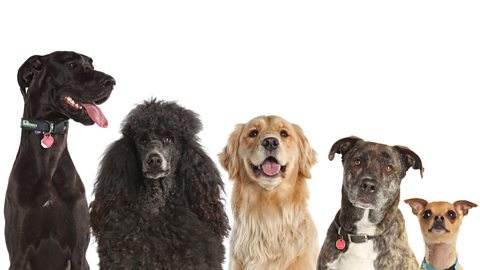Variation and mutation
Variation is the differences in the characteristics of organisms. It can be caused by the genes an individual inherits or the environment it lives in.
Extensive genetic variation is contained within a population of any species and is clearly visible in the domestic dog species, as shown in the photograph below.

Variation within genes leads to different genotypeThe alleles that an organism has for a particular characteristic, usually written as letters., which can be seen by the individuals having different phenotypeThe visible characteristics of an organism which occur as a result of its genes.. For example, the dogs above all have different fur colours and fur lengths.
Genetic and environmental variation combine together to produce these different phenotypes. All genetic variants arise from mutationA random and spontaneous change in the structure of a gene, chromosome or number of chromosomes..
Mutations
A mutation is a random change in DNA which therefore affects a geneThe basic unit of genetic material inherited from our parents. A gene is a section of DNA which controls part of a cell's chemistry - particularly protein production. and/or chromosomeThe structure made of DNA that codes for all the characteristics of an organism.. Most mutations have no effect on the phenotype. Some influence phenotype to some extent. Very few create a new phenotype. Mutations can be inherited and therefore passed on from one individual to another. If a mutation causes a new phenotype that makes an organisms better suited to a particular environment, it can lead to rapid change in the characteristics of the individuals in that species.
For example, if a mutation led to brighter feather colouring in birds, the brighter feathers may allow those individuals with the mutation to reproduce more frequently, because they are seen as being more attractive and a desirable mate. This would result in the bright feather phenotype being more likely to be passed on, meaning that over time there will be more bright feathered birds compared to the birds of the same species without the new phenotype.